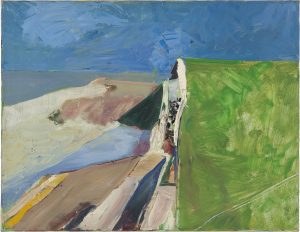de Young Museum: Diebenkorn and the Aerial View
July 6, 2020
By Emma Acker

The modestly sized oil-on-canvas Seawall (1957) is one of six paintings and hundreds of works on paper by Richard Diebenkorn (1922–1993) in the collection of the Fine Arts Museums of San Francisco. Diebenkorn was one of the most influential American artists working in the post-World War II era, and Seawall, despite its small scale, has a visceral immediacy, as it powerfully evokes an elemental meeting of sea, sky, and earth. The painting is meditative and restorative, just as I find the California landscape to be, and it has long been one of my favorite artworks in the collection. Like many of the works Diebenkorn produced during his “Berkeley period” (1953–1966), the open structure and sweeping brushwork of Seawall stem not only from the vocabulary of modernist abstraction but also from the elevated vantages and new visual terrain that the artist experienced in 1951 during his first cross-country flight.
Diebenkorn used an aerial perspective in many of the abstract and representational works he produced while living in Northern California as a way to express his visual, sensory, and emotional impressions of the unique climate and topography of the Bay Area—a landscape in which he was deeply rooted. Diebenkorn was born in Portland, Oregon, but moved to San Francisco with his family when he was just two years old. He grew up in Ingleside Terraces, a residential neighborhood at the southern end of the city about two miles from the Pacific Ocean. Diebenkorn completed the majority of his education in the Bay Area, attending Lowell High School in San Francisco; Stanford University in Palo Alto; and the California School of Fine Arts (now the San Francisco Art Institute) in San Francisco.